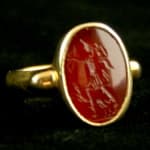Gold Ring Featuring a Classical Revival Carnelian Seal Depicting Diana, 18th Century CE - 19th Century CE
Gold and Carnelian
FJ.7258
This genuine antique Classical Revival carnelian seal has been mounted in a modern 18 karat gold ring. The art of glyptics, or carving on colored precious stones, is probably one...
This genuine antique Classical Revival carnelian seal has been mounted in a modern 18 karat gold ring.
The art of glyptics, or carving on colored precious stones, is probably one of the oldest known to humanity. Intaglios, gems with an incised design, were made as early as the fourth and third millennia B.C. in Mesopotamia and the Aegean Islands. The exhibit a virtuosity of execution that suggests an old and stable tradition rooted in the earliest centuries. The tools required for carving gems were simple: a wheel with a belt-drive and a set of drills. Abrasives were necessary since the minerals used were too hard for a metal edge. A special difficulty of engraving intaglios, aside from their miniature size, was that the master had to work with a mirror-image in mind.
Most frequently identified as goddess of the hunt, Diana (known to the Greeks as Artemis) was particularly concerned with periods of transition, i.e., the rites of passage of virgins becoming women, or young boys becoming men through hunting or war. Though eternally virginal herself, she presided over childbirth and the rearing of children. In fact, as soon as she was born, Diana helped her mother give birth to her twin brother Apollo. Her own transformation occurred at the famous temple of Ephesus where she became an “earth mother” with multiple breasts.
The art of glyptics, or carving on colored precious stones, is probably one of the oldest known to humanity. Intaglios, gems with an incised design, were made as early as the fourth and third millennia B.C. in Mesopotamia and the Aegean Islands. The exhibit a virtuosity of execution that suggests an old and stable tradition rooted in the earliest centuries. The tools required for carving gems were simple: a wheel with a belt-drive and a set of drills. Abrasives were necessary since the minerals used were too hard for a metal edge. A special difficulty of engraving intaglios, aside from their miniature size, was that the master had to work with a mirror-image in mind.
Most frequently identified as goddess of the hunt, Diana (known to the Greeks as Artemis) was particularly concerned with periods of transition, i.e., the rites of passage of virgins becoming women, or young boys becoming men through hunting or war. Though eternally virginal herself, she presided over childbirth and the rearing of children. In fact, as soon as she was born, Diana helped her mother give birth to her twin brother Apollo. Her own transformation occurred at the famous temple of Ephesus where she became an “earth mother” with multiple breasts.



